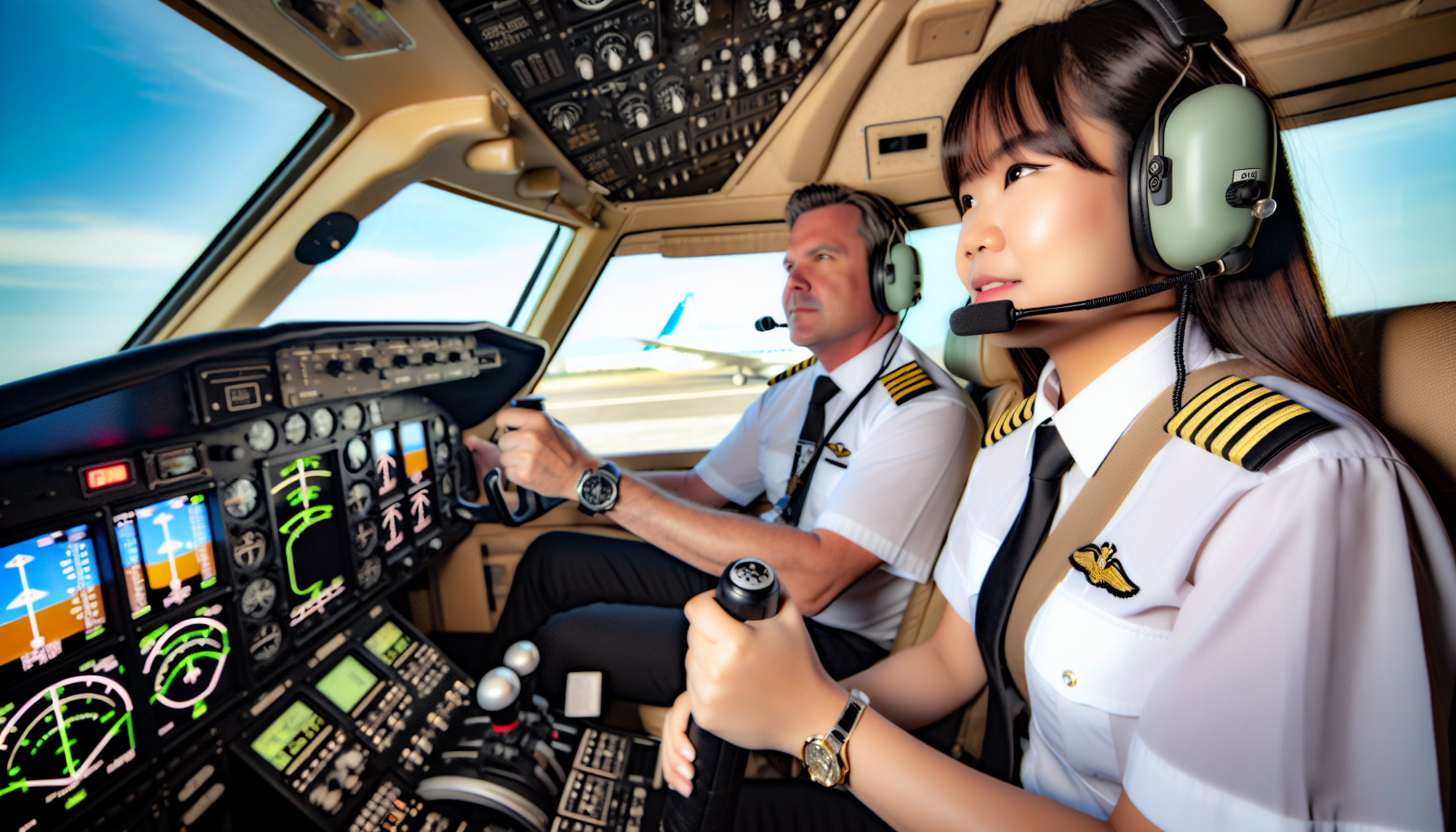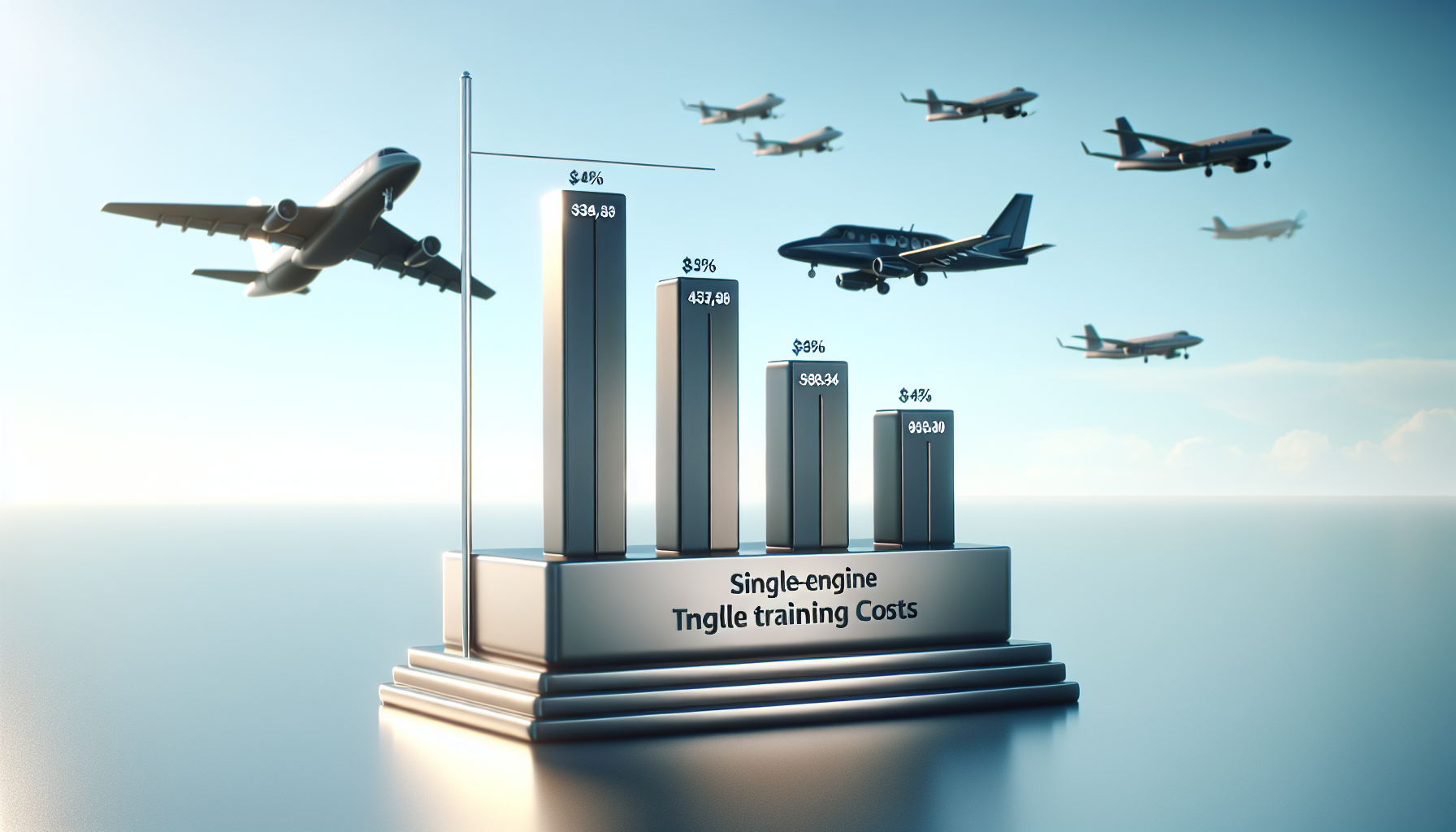Multi Engine Rating Cost: What Pilots Should Expect to Pay
Feb 27, 2024
The roar of powerful engines, the thrill of soaring through the skies, and the freedom to explore the world from above – these are just some of the many allures of piloting multi-engine aircraft. With more power, range, and safety features, obtaining a multi-engine rating can open up new career opportunities and enhance your flying experience. But before you can take to the skies in a powerful twin-engined machine, it’s essential to understand the multi engine rating cost involved in obtaining this coveted certification.
In this comprehensive guide, we will walk you through the various expenses associated with acquiring a multi-engine rating, discuss the path to earning it, compare the multi engine rating cost of single-engine and multi-engine training, and explore financing options to help you reach your aviation goals.
Key Takeaways
-
Multi Engine Rating costs range from $2,000 to $6,000 and include aircraft rental, instructor fees and FAA examiner fees.
-
Prerequisite certifications are required before beginning training with an in-depth program providing instruction on flight maneuvers for successful completion of a final check ride.
-
Obtaining a multi engine rating provides increased safety, new career opportunities and faster flight times making it a beneficial investment for aspiring pilots.
Breaking Down the Cost of a Multi Engine Rating

Before you start your multi-engine training, you need to consider the costs associated with achieving this certification. On top of the expenses for your private pilot license, you’ll need to account for additional costs specific to your multi-engine rating, which are estimated to range from $2,000 to $6,000. These costs mainly comprise aircraft rental, instructor fees, and additional expenses such as study materials and FAA examiner fees.
Let’s analyze the cost components of multi-engine training to better understand the financial implications. These components include aircraft rental expenses, instructor fees for flight and ground training, and other expenses such as study materials and FAA examiner fees.
Aircraft Rental Expenses
Aircraft rental is one of the most significant expenses in multi-engine training. The cost of renting a multi-engine aircraft can vary depending on factors such as:
-
The type of aircraft
-
The length of the rental
-
The age, size, and model of the aircraft
-
The rental policies of the flight school or rental company
According to available data, the average cost of multi-engine aircraft rental per hour ranges from $150 to $350.
Another factor that can affect the cost of multi-engine aircraft rental is the rental duration. Generally, extended rental periods may be associated with reduced rates compared to shorter rentals. To obtain accurate pricing information, it’s advisable to contact your chosen flight school or rental company for their specific rental rates based on the aircraft type and duration.
Instructor Fees for Flight and Ground Training
Instructor fees for both flight and ground training are an essential part of the multi-engine rating cost. These fees can vary depending on factors such as the instructor’s experience and location. The average cost of flight instructor fees for multi-engine training is typically around $60 per hour. For ground training, instructor fees range from $60 to $170 per hour.
Consider that the instructor’s experience level can influence the cost of multi-engine training. Instructors with more experience may command higher fees due to their specialized knowledge and qualifications. To obtain the most accurate fee information, contact individual aviation schools directly to inquire about their instructor fees for multi-engine training.
Additional Costs
Aside from aircraft rental and instructor fees, there are additional costs to consider when pursuing a multi-engine rating. Study materials, for example, can range from $50-150. Additionally, FAA examiner fees for a multi-engine rating test are typically around $600, although the actual cost may vary depending on the location and the individual examiner.
Lastly, travel expenses may be incurred if you need to relocate or commute to a specific location for your multi-engine training. Be sure to budget for these additional expenses when planning your multi-engine training journey.
The Path to Earning Your Multi Engine Rating

Now that you are aware of the costs involved in getting a multi-engine rating, we will outline the process for earning this certification. The process includes meeting prerequisite certifications, completing an in-depth training program, and successfully passing a final check ride.
Next, we will cover:
-
The necessary prerequisite certifications for multi-engine training
-
The extensive training program including systems, aerodynamics, emergency operations, and flight maneuvers
-
The check ride as the concluding step to certification
Prerequisite Certifications
Before you can begin your multi-engine training, there are certain prerequisite certifications you must have in place. First, you will need a single-engine pilot license. This certification is essential because it demonstrates your foundational knowledge and skills as a pilot, providing a solid basis for your multi-engine training. The process of obtaining a single-engine pilot license involves completing ground training, accumulating flight hours, and passing both written and practical examinations.
In addition to a single-engine private pilot certificate, you will also need a current FAA medical certificate. This pilot certificate is crucial in ensuring that you are in good health and meet the medical fitness requirements for operating a multi-engine aircraft. The process for obtaining a current FAA medical certificate involves completing the application form and undergoing an exam with a certified Aviation Medical Examiner (AME).
In-Depth Training Program
With your prerequisite certifications secured, you are prepared to start your comprehensive multi-engine training program. This comprehensive program covers a wide range of topics, including:
-
Aircraft systems
-
Aerodynamics
-
Emergency operations
-
Flight maneuvers
The goal is to equip you with the knowledge and skills necessary to safely and efficiently operate multi-engine aircraft and obtain your flight instructor certificate.
During your multi-engine training, you will spend time both on the ground and in the air, learning about the unique characteristics and challenges associated with flying multi-engine airplanes. Ground training will cover subjects such as aircraft systems, weight and balance calculations, and the aerodynamics of multi-engine aircraft. Flight training will focus on typical and emergency multi-engine aircraft maneuvers and operations.
The Check Ride: Final Step to Certification
The final step to obtaining a multi-engine rating is the check ride, a practical examination conducted by an authorized instructor to evaluate your proficiency in flying a multi-engine aircraft. The check ride is a crucial component of your multi-engine training, as it ensures that you have the necessary skills and knowledge to safely operate a multi-engine aircraft in various situations.
During the check ride, you will be evaluated on scenarios and maneuvers such as:
-
Engine identification
-
Engine failure
-
Vmc demonstration
-
Single-engine operations
-
Emergency procedures
-
Maneuvering
Successfully completing the check ride is a testament to your hard work and dedication throughout your multi-engine training and signifies that you are ready to take on the challenges and rewards of flying multi-engine aircraft.
Time Investment for Multi Engine Training

One key aspect to consider when planning your multi-engine training is the time commitment needed to finish the program. The average flight time needed for a multi-engine rating varies, but typically ranges from 10 to 25 hours. This time includes both ground and flight training, and the actual time required may depend on factors such as your manual flying proficiency, the frequency of flying, and your availability.
In addition to the average flight time needed, you’ll also need to choose between accelerated courses or traditional pacing for your multi-engine training. Accelerated courses offer a faster path to obtaining your multi-engine rating, while traditional pacing allows for more flexibility in scheduling.
Average Flight Time Needed
As mentioned earlier, the average flight time needed for a multi-engine rating typically ranges from 10 to 25 hours. This time investment is crucial for gaining the skills and knowledge necessary to safely and efficiently operate multi-engine aircraft. It’s worth noting that the actual time required may vary depending on factors such as your manual flying proficiency, the frequency of flying, and your availability.
Prior flight experience can also play a role in reducing the average flight time needed for a multi-engine rating. Pilots with extensive single-engine experience may find that they require less time to become proficient in multi-engine aircraft, saving both time and money in the process.
Accelerated Courses vs. Traditional Pacing
When deciding on the pacing of your multi-engine training, you have the option of choosing between accelerated courses and traditional pacing. Accelerated courses are designed to be completed in a shorter timeframe, usually within a few weeks. These courses are intensive and require a significant time commitment from the learner.
On the other hand, traditional multi-engine training courses are conducted over a longer duration, often several months to a year, and generally offer more flexible scheduling options. Both accelerated courses and traditional pacing have their advantages and disadvantages. Accelerated courses can lead to faster certification, but may also come with a heavier workload and limited scheduling options.
Traditional pacing allows for more flexibility and potentially a more thorough learning experience, but may take longer to complete. Ultimately, the choice between accelerated courses and traditional pacing will depend on your individual needs, goals, and availability.
Financing Your Multi Engine Rating

Obtaining a multi-engine rating can be a substantial financial investment. However, there are various financing options available to help aspiring pilots cover the cost of their multi-engine training. Some of these options include:
-
Scholarships
-
Grants
-
Loan programs
-
Payment plans
These options can provide financial assistance for those unable to afford the full cost of a multi-engine rating upfront.
Next, we will cover the various financing options available, such as scholarships and grants, loan programs, and payment plans. These options can assist you in achieving your dream of flying multi-engine aircraft without straining your finances.
Scholarships and Grants
There are numerous scholarships and grants available for aspiring pilots to help cover the cost of multi-engine training. Some of these include:
-
Envoy Air’s Future Airline Pilot scholarship
-
Experimental Aircraft Association (EAA) Flight Training Scholarships
-
AAERO Aviation Scholarship Program
-
Aircraft Owners and Pilots scholarships
These scholarships can significantly reduce the financial burden of obtaining a multi-engine rating, making it more accessible for a wider range of aspiring pilots.
When seeking scholarships and grants, it’s important to research the specific eligibility criteria and application processes for each opportunity. Keep in mind that some scholarships may be offered by airlines or aviation organizations, so be sure to explore all your options and apply for scholarships that align with your goals and qualifications.
Loan Programs and Payment Plans
Loan programs and payment plans can also provide financial assistance for those unable to afford the full cost of a multi-engine rating upfront. Loan programs for multi-engine pilot training are available from various financial institutions and organizations that specialize in aviation financing. These loans can be used to cover expenses such as:
-
flight hours
-
instructor fees
-
aircraft rental
-
examination fees
The loan terms and conditions may vary depending on the lender, but generally, the borrower must meet certain eligibility criteria and provide documentation such as proof of enrollment in a multi-engine pilot training program.
Payment plans for multi-engine rating training typically allow aspiring pilots to finance the cost of their training over a period of time. These payment plans may be offered by flight training schools or through specialized financing companies and typically include tuition, flight hours, and other associated expenses for flight training programs. The specific terms and conditions of the payment plan, such as interest rates and repayment period, may vary depending on the provider. It is recommended to consider different financing options and compare their terms before making a final decision.
Comparing Single Engine and Multi Engine Training Costs

It’s useful to compare the costs of multi-engine training with those of single-engine training when considering expenses. While the average cost of single-engine flight training can range from $5,000 to $10,000, depending on the type of license and number of flight hours required, multi-engine flight training costs typically range from $2,000 to $6,000. This cost difference highlights the additional expenses associated with multi-engine rating, such as:
-
Higher aircraft rental fees
-
Fuel costs
-
Instructor fees
-
Maintenance and insurance costs
-
Additional flight hours
Remember, investing in a multi-engine rating can offer several benefits including enhanced safety, improved job prospects, and the capability to fly at higher speeds and over longer distances. When comparing the costs of single-engine and multi-engine training, consider the potential advantages and opportunities that a multi-engine rating can offer, as well as the benefits of obtaining a single engine airplane rating.
Advantages of Investing in a Multi Engine Rating
Investing in a multi-engine rating offers several benefits. One of the most significant benefits of obtaining a multi-engine rating is the increased safety that comes with flying aircraft equipped with more than one engine. In the event of an engine failure, a multi-engine aircraft provides a safety net by allowing the aircraft to continue flying and land safely with the remaining engine(s).
In addition to increased safety, a multi-engine rating can also open up new career opportunities for aspiring pilots. With a multi-engine rating, pilots can qualify for jobs with airlines, cargo carriers, and other aviation organizations that require the ability to fly multi-engine aircraft. Furthermore, multi-engine aircraft are typically faster and have a greater range than single-engine aircraft, allowing pilots to fly longer distances and reach their destinations more quickly. These advantages make investing in a multi-engine rating a worthwhile endeavor for any aspiring pilot.
Real Stories: Pilots Reflect on Their Multi Engine Training Experience
Listening to firsthand experiences from pilots who have completed their multi-engine training can offer meaningful perspectives on the merits and challenges of obtaining a multi-engine rating. Some benefits reported by pilots include:
-
Building confidence in handling emergencies
-
Gaining experience in managing complex systems
-
Accumulating valuable multi-engine Pilot-in-Command (PIC) time
These experiences highlight the value of multi-engine training for commercial pilot aspirants and the importance of a designated pilot examiner in the process.
However, pilots also reflect on the challenges of multi-engine instruction, such as dealing with engine failures, managing complex aircraft systems, and the higher costs associated with multi-engine training. These real-life stories serve as a reminder of the dedication, hard work, and perseverance required to achieve a multi-engine rating and the rewards that come with it.
Summary
In summary, obtaining a multi-engine rating is an exciting and rewarding endeavor that can open up new career opportunities and enhance your flying experience. While the costs associated with multi-engine training can be substantial, various financing options, such as scholarships, grants, loan programs, and payment plans, can help aspiring pilots cover these expenses.
By understanding the costs, time investment, and advantages of investing in a multi-engine rating, you can make an informed decision about whether this certification is right for you. With dedication, hard work, and the right resources, the sky’s the limit when it comes to your multi-engine flying dreams.
Frequently Asked Questions
How much does it cost to add multi engine rating?
The Multi Engine Rating typically costs apprximately $2000-6000, inclusive of fuel. Examiner fees are not included.
Is a multi engine rating worth it?
Having a multi-engine rating is recommended if your flight plans include crossing dangerous terrain. It can give you peace of mind in the event of an emergency, and will help make your dream flights over mountains or oceans much safer.
What does it take to get multi engine rating?
Gaining a multi engine rating does not require a specific number of flight hours. Rather, the student must learn and show proficiency in multi engine systems and procedures.
What financing options are available for multi-engine training?
Financing options for multi-engine training include scholarships, grants, loan programs, and payment plans, providing a variety of ways to fund the training.
How does multi-engine training differ from single-engine training in terms of cost?
Multi-engine training is generally more expensive than single-engine due to the increased costs of aircraft rental, fuel, instructor fees, maintenance and insurance, and additional flight hours.
Do you need multi engine rating for a commercial license?
No, you do not need to obtain a multi engine rating if you are seeking a Commercial Pilot License. However, if you don't have the multi engine rating before getting the commercial pilot license, you won't be able to be paid for flying multi engine aircraft. It is advised to get the multi engine rating before the commercial pilot certificate as it is easier, less expensive, and less time consuming in this order.
